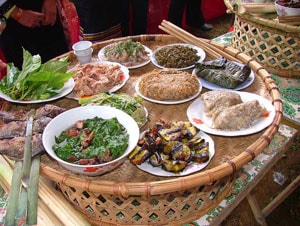Kin Pa tray of offerings on Thai New Year's Day
(Baonghean) -Each ethnic minority in the Vietnamese ethnic community has its own way of celebrating Tet with different rituals and activities. For the Thai ethnic group in the mountainous district of Con Cuong, the most unique feature is the Kin Pa tray.
After a year of hard work, when Tet comes, people are busy preparing to clean their houses, wear new clothes, prepare peach blossoms, bamboo poles, fruit trays, areca and betel leaves, and food to prepare Tet feasts. On the 30th of Tet, according to custom, all members of the Thai family wash their hair, and the stove must be kept red and not turned off. This custom has the meaning of sending off bad luck in the old year, welcoming joy and happiness in the coming new year.
To prepare for the Tet feast, before the 30th of December, the men in the family must go to the river, stream or pond to catch fish. People choose the biggest fish, split it from the back, clean the intestines and skewer it on bamboo sticks and put it on the charcoal stove to grill it, called ca dau co or ca dau tram. The smaller fish are left whole, wrapped in dong leaves or banana leaves and put in the pot, some are pounded with onions, sticky rice, and wild banana trees to make mooc. Usually, the tasks of catching fish, preparing fish, preparing chicken, and butchering pork are all done by the men in the family, the women in the family often take on the task of making sticky rice, wrapping cakes, and wrapping mooc. In the Thai people's feast, fish is an indispensable dish to offer to ancestors and gods.

Tet feast of Thai people in Western Nghe An. Photo: PV
In addition to fish, banh chung, croissant cakes, and large banh chung are made in pairs to pray for everyone to have a partner, a happy family. The cakes are made from new sticky rice with an average quantity of a few dozen for each family. If the family has many children, hundreds of cakes must be wrapped to express gratitude to ancestors and heaven and earth for blessing a year of favorable weather and wind, bountiful crops, praying for a successful crop in the new year, wishing family members to be warm, happy, healthy children and grandchildren, and to know how to love each other.
The morning offering tray on the first day of Tet is called "Kin Pa" and is displayed on a tray or on a basket that the family usually uses to store and dry rice. The tray has all kinds of cakes, sticky rice, chicken, grilled fish, pork, pig intestines, a bowl of honey, a bowl of cold water, a bowl of dipping sauce. In addition, a set of men's clothes, a set of women's clothes with earrings, bracelets, and necklaces are prepared to worship the ancestors. After the tray is prepared, the whole family carries the tray to the altar together. The custom of carrying the tray shows the gratitude of descendants to their ancestors. When the year ends and the New Year comes, the descendants prepare a lot, fully, with high trays and full dishes to offer to grandparents and ancestors, praying for a prosperous business next year and peace for the descendants. The father of the family or the shaman will read the prayer and express the wishes and aspirations of the descendants.
After the offering, the children and grandchildren bow 5 times before the family altar. Before eating Kin Pa, the Thai people hang their nets on a pole, attach packages of mooc and grilled fish to the net, then recite words of thanks to the river and stream gods for allowing the fish to form schools so they can catch them to make delicious dishes, hoping that this year they will catch a lot of shrimp and fish.
Next, the whole family gathers together to eat, celebrate the new year, and wish for good things. Grandparents and parents peel croissants for their children and grandchildren, hoping that their children will be as healthy as buffaloes. Adults toast each other with a cup of wine at the beginning of the year so that the whole year will be happy and harmonious. After finishing the feast, everyone in the family gives each other New Year's wishes, sings tunes together to thank heaven and earth, thank grandparents and ancestors for blessing their children and grandchildren, wish for a new year with a successful harvest, and thank the Party and State for caring for and looking after the lives of the people.
The Kin Pa tray on the first day of Tet of the Thai people not only shows the uniqueness of the nation's culinary culture, but also represents beliefs, profound human values, values that need to be preserved and developed, not only having cultural and tourist significance but also preserving for future generations.
Bao Ngoc - Thu Trang (Con Cuong Radio)






